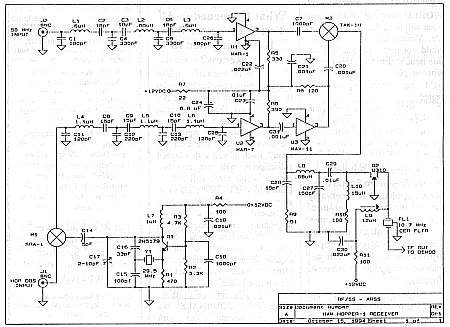
Ham Hopper-1 Update
The Ham Hopper breadboard receiver development is making good progress. The schematic below reflects the current design of the RF front end, hopping DDS LO upconverter and 10.7 MHz IF filtering / impedance matching circuitry. The rest of the circuitry needed for the receiver is contained in the IF/demodulator function of the receiver, which is still being worked on.

Ham Hopper-1 RF/LO/IF Filter Schematic
Early tests of this receiver front end used the Ham Hopper TX DDS as the source of the frequency hopped DDS signal for LO upconversion. This, of course, guarantees that the transmitter and receiver are in "real time" synchronization. In The actual Ham Hopper transceiver, the receiver cannot be tied to the remote transmitter, so it must synchronize frequency hop timing to the incoming signal. This is one of the jobs of the demod function.
Every transmission from a Ham Hopper will start with a " preamble," which is used by the receiver to determine the start of a received packet burst. When a receiver is first turned on it looks for a preamble on hop channel number "0" -- if a valid preamble is detected the receiver then starts demodulating the received data. The end of every packet burst contains an "End of Message" character, which the receiver uses to determine the approximate time of the start of the next burst. The receiver needs to know this start time so that it can hop to the next pseudo randomly selected frequency (or hop channel). Once set up on the next hop channel, the receive can again start looking for another "sync" preamble.
Now you have an idea how the overall system works in its burst packetized data transmission mode. If there are plenty of signals on the air, each receiver continuously keeps track of "system timing" -- however, if packet traffic is sparse then the preamble approach makes sure that bursts can get through.
Next month we will give more details of the receiver and IF / demodulator designs along with complete parts lists and some preliminary test results. Stay tuned and write or FAX if you are interested in the Ham Hopper Kit.
Return to Table of Contents for this issue

In October 2000, this website and the copyright to all editions of
Spread Spectrum Scene Online was purchased by
SSS Online, Inc., and is operated by
Pegasus Technologies. For more of the best information
on RF, Spread Spectrum and wireless, press one of the buttons below:

|
|
|